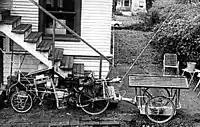Portable operation (amateur radio)
Amateur radio operators take part in portable operations using radio equipment when traveling. "Portable" equipment indicates a configuration that allows for relatively rapid collection, transportation, and deployment of amateur radio gear. A portable station can be anything from a small QRP (Low Power) radio and antenna, to a large transceiver. On long-distance expeditions, such equipment allows them to report progress, arrivals and sometimes exchanging safety messages along the way.[1][2]
Portable operations

'Portable' operation is usually signified by amateur radio operators appending the suffix '/P' to their callsign. Operating '/P' normally means that stations are operating away from their licensed station address.
The advantages of /P operation include the use of large empty spaces where full size beam and wire antennas can be erected on tall trailer mounted masts. If operating on VHF/UHF, this can mean a location on the top of a hill or cliff, with clear line of sight to the horizon. The main disadvantage is normally the power supply available. As normal mains grid power is unavailable, the /P operator may have to resort to batteries, portable generators, solar panels.[3] and wind turbines.
Operating amateur radio at sea is known as 'maritime mobile', as is signified by the suffix '/MM' on the call. Operating amateur radio from a vehicle is known as 'Mobile', as is signified by the suffix '/M' on the call.
A popular pastime for portable operation is the Summits on the Air programme, part of which involves portable operation from a worldwide list of over 73,500 summits.
Some countries allow the direct connection of amateur transceivers to telephone lines called "phone patching".[4] Thus, a traveler may be able to call another amateur station and, via a phone patch, speak directly with someone else by telephone.
Notes
- Stuart Thomas (2018). Portable Operating for Amateur Radio: Everything You Need to Get on the Air in the Great Outdoors!. American Relay Radio League, Incorporated. ISBN 978-1-62595-080-2.
- H. Ward Silver (2 March 2018). Ham Radio For Dummies. Wiley. ISBN 978-1-119-45486-1.
- "Ham(Radio)ing it Up with Solar Power". KE2YK. 7 December 2007. Retrieved 2009-07-31.
- "Phone Patch, Autopatch and HF/VHF/UHF Operating Guidelines". American Radio Relay League. Archived from the original on 2006-11-30. Retrieved 2007-01-10.
